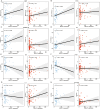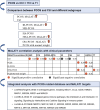MALAT1 expression in granulosa cells in PCOS patients with different phenotypes
- PMID: 38424234
- PMCID: PMC10904732
- DOI: 10.1038/s41598-024-55760-9
MALAT1 expression in granulosa cells in PCOS patients with different phenotypes
Abstract
Polycystic ovary syndrome (PCOS) is one of the most common reproductive endocrine metabolic disorders. The lncRNA metastasis-associated lung adenocarcinoma transcript 1 (MALAT1) reportedly can regulate the reproductive system. Despite studies, the alteration of MALAT1 expression in granulosa cells (GCs) from PCOS patients was inconsistent. To evaluate MALAT1 expression in GCs in different PCOS subgroups and its association with PCOS phenotypes, we collected GCs from 110 PCOS cases and 71 controls, and examined MALAT1 expression by quantitative PCR. The results showed MALAT1 expression was upregulated in PCOS cases, especially in insulin resistant (IR) PCOS subgroup, obese PCOS subgroup and non-hyperandrogenic (NHA) PCOS subgroup. MALAT1 expression was positively correlated with BMI and several metabolic parameters in controls. Interestingly, MALAT1 expression was notably associated with some critical endocrine indexes for PCOS, including E2, FSH, LH and LH/FSH ratio. In different PCOS subgroups, we found significant positive correlations with LH/FSH ratio in IR-PCOS and PCOS with normal weight, and with serum T and LH level in NHA-PCOS subgroup. Integrated analysis with lncRNA target databases and PCOS-related databases revealed MALAT1 could participate in PCOS by influencing immune response and lipids metabolism in GCs. In conclusion, MALAT1 was differently expressed in GCs in PCOS, especially in IR, obese and NHA PCOS subgroups. MALAT1 was likely involved in metabolism and immune response in GCs in PCOS. However, more studies are necessary to establish this concept.
Keywords: Granulosa cells; Long noncoding RNA; MALAT1; Metabolism; Polycystic ovary syndrome.
© 2024. The Author(s).
Conflict of interest statement
The authors declare no competing interests.
Figures






Similar articles
-
Effect of lncRNA MALAT1 on the Granulosa Cell Proliferation and Pregnancy Outcome in Patients With PCOS.Front Endocrinol (Lausanne). 2022 Apr 27;13:825431. doi: 10.3389/fendo.2022.825431. eCollection 2022. Front Endocrinol (Lausanne). 2022. PMID: 35573984 Free PMC article.
-
MALAT1 is involved in the pathophysiological process of PCOS by modulating TGFβ signaling in granulosa cells.Mol Cell Endocrinol. 2020 Jan 1;499:110589. doi: 10.1016/j.mce.2019.110589. Epub 2019 Sep 23. Mol Cell Endocrinol. 2020. PMID: 31557499
-
Down-regulation of MALAT1 aggravates polycystic ovary syndrome by regulating MiR-302d-3p-mediated leukemia inhibitory factor activity.Life Sci. 2021 Jul 15;277:119076. doi: 10.1016/j.lfs.2021.119076. Epub 2021 Jan 16. Life Sci. 2021. PMID: 33465389
-
Long noncoding RNAs as a piece of polycystic ovary syndrome puzzle.Mol Biol Rep. 2021 Apr;48(4):3845-3851. doi: 10.1007/s11033-021-06196-1. Epub 2021 May 15. Mol Biol Rep. 2021. PMID: 33993404 Review.
-
Interactions between androgens, FSH, anti-Müllerian hormone and estradiol during folliculogenesis in the human normal and polycystic ovary.Hum Reprod Update. 2016 Nov;22(6):709-724. doi: 10.1093/humupd/dmw027. Epub 2016 Aug 27. Hum Reprod Update. 2016. PMID: 27566840 Review.
Cited by
-
Integrated Transcriptomics and Single-Cell RNA Sequencing Analyses Reveal the Potential Role of Obesity-Related Genes in Polycystic Ovary Syndrome.Reprod Sci. 2025 Aug 29. doi: 10.1007/s43032-025-01968-7. Online ahead of print. Reprod Sci. 2025. PMID: 40880058
References
MeSH terms
Substances
Grants and funding
- 2021YFC2700400/National Key Research and Development Program of China
- 2021YFC2700400/National Key Research and Development Program of China
- 32370916/National Natural Science Foundation of China
- 82101707/National Natural Science Foundation of China
- ZR2023YQ061/Natural Science Foundation of Shandong Province for Excellent Youth Scholars
- Q2022144/Program for Chang Jiang Scholars
- ts20190988/Taishan Scholars Program of Shandong Province
- 2023QNTD004/Fundamental Research Funds of Shandong University
- 31988101/the Basic Science Center Program of NSFC
- 2021-I2M-5-001/CAMS Innovation Fund for Medical Sciences
- 2020ZLYS02/Shandong Provincial Key Research and Development Program
LinkOut - more resources
Full Text Sources
Medical

